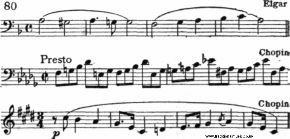EXTEMPORE PLAYING - online tutorial
40 Lessons in how to correctly play improvisations.
| Share page | Visit Us On FB |
|
LESSON XXIII |
|||
|
Melody: Fundamentals
The course of study up to now has been directed with a view to gaining knowledge and experience of chord-progressions. While this has been carried on it has been inevitable that some sort of melodic line should be included, i.e., if by melody is understood the outline formed by the highest, or soprano, part.
It is time now to turn the attention to the formation of melodic lines for their own sake, and more or less independently of harmony.
Parenthetically, it may be questioned whether it is possible for a modern musician to think of a melody entirely detached from harmonic foundations; and this is probably as it should be. This it is that supplies the distinction between ancient and modern melody. The former, having been invented before harmony came into being, is pure melody; the latter, reflecting harmonic influence, is of a mixed nature.
Nevertheless, in the most modern music it is a common thing to meet with melodic lines unaccompanied by any harmony, and these are frequently introduced with striking effect; e.g., |
|||
 |
\etc. throughout the movement |
||
|
How can melody be correctly constructed? Are there any guiding principles ?
The two essentials of melody are (a) outline—concerned with rise and fall, and (b) rhythm—concerned with duration |
|||
|
[60] |
|||